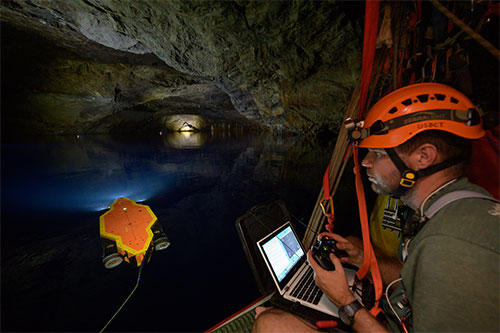Technician operating a SUNFISH robot in a cave in Namibia. |
The team will travel to the region in 2022 and 2023 to explore underwater caves located around Prince of Wales Island using a SUNFISH® AUV, a cutting-edge robot that can navigate environments on its own while creating a real-time, 3-D map. The SUNFISH can document places inaccessible to divers and use the map it created along the way to find its way back to the surface. It may also be maneuvered by divers.
One of SHI’s major goals is to increase the knowledge of Southeast Alaska Native culture and history through documentation of traditional ecological knowledge and through scientific research. The project has the potential to teach Native people about their ancestors who lived in the area many thousands of years ago, said SHI President Rosita Worl.
“We know much of the terrain that is below sea level now was above ground and accessible to our people approximately 17,000 years ago. For the first time, technology is allowing us to document these places our ancestors called home. It’s a game changer,” Worl said.
The area around Prince of Wales Island has been of interest to scientists for years. In 1996, a paleontologist exploring a cave there discovered human remains that proved to be those of a young Native man who lived more than 10,000 years ago. At the time, the remains were the oldest ever discovered in Alaska and Canada.
“This investigation may reveal an even earlier migration and occupation of Southeast Alaska,” Worl said.
Later DNA tests showed genetic continuity between the young man, named Shuká Kaa (Man Before Us) by Native people, and Native people living in the area today. The 2017 study of the DNA in the ancient skeletal remains added to the evidence that indigenous groups living today in southern Alaska and the western coast of British Columbia are descendants of the first humans to make their home in northwest North America more than 10,000 years ago.
In 2007, The U.S. Forest Service conveyed custody of Shuká Kaa (Man Before Us) to Tlingit tribes in Klawock and Craig, marking the first time a federal agency had transferred remains of such antiquity to a Native American or Alaska Native tribe. The transfer came after the Klawock Cooperative Association, the Craig Community Association and Sealaska petitioned the agency for the remains. The tribes made the request at the end of a multi-year, collaborative project to study Shuká Kaa.
During the project, the team will locate submerged cave and rock shelter entrances using side-scan sonar, generate 3-D maps of the caves, collect underwater film and still imagery and sample sediments from cave floors. Data gathered will provide information about the paleoenvironment and its changes over time, including plants, sea-level, past depositional environment and submergence events, sea-surface temperature and salinity and primary marine productivity.
If artifacts are recovered during the project, they will be curated by Sealaska Heritage Institute (SHI),
Research Team
This project brings together a highly experienced team from around North America organized by Sunfish Inc. and Sealaska Heritage Institute. The team includes: Dr. Kristof Richmond (PI), a robotics engineer at Sunfish; Dr. Kelly Monteleone (co-PI), an archaeologist at the University of Calgary; Dr. Rosita Worl, an anthropologist from Sealaska Heritage Institute; Dr. Vera Pospelova, who specializes in dinoflagellate Cyst analysis from the University of Minnesota; Dr. Nancy Bigelow, who specializes in microfossil and pollen analysis from the University of Alaska, Fairbanks; Jill Heinerth, the lead diver and Education/Outreach specialist; Vickie Siegel,the field operations manager for Sunfish; Kristi Erickson, the project manager for Sunfish; and additional Sunfish team members. SHI also plans to bring interns majoring in sciences. The project will hire local residents to participate in the project, and tribal representation will be coordinated through Sealaska Heritage Institute. Additionally, National Oceanic and Atmospheric Administration and United States Geological Survey Tongass Forest Service representatives may participate throughout the project.
Edited by Mary Kauffman, SitNews
On the Web:
PHAS Research Article - May 2017 - “Ancient individuals from the North American northwest coast reveal 10,000 years of regional genetic continuity
Source of News:Sealaska Heritage Institute (SHI)
www.sealaskaheritage.org
Representations of fact and opinions in comments posted are solely those of the individual posters and do not represent the opinions of Sitnews.
Send a letter to the editor@sitnews.us
SitNews ©2022
Stories In The News
Ketchikan, Alaska
Articles & photographs that appear in SitNews are considered protected by copyright and may not be reprinted without written permission from and payment of any required fees to the proper freelance writers and subscription services.
E-mail your news & photos to editor@sitnews.us
Photographers choosing to submit photographs for publication to SitNews are in doing so granting their permission for publication and for archiving. SitNews does not sell photographs. All requests for purchasing a photograph will be emailed to the photographer.

